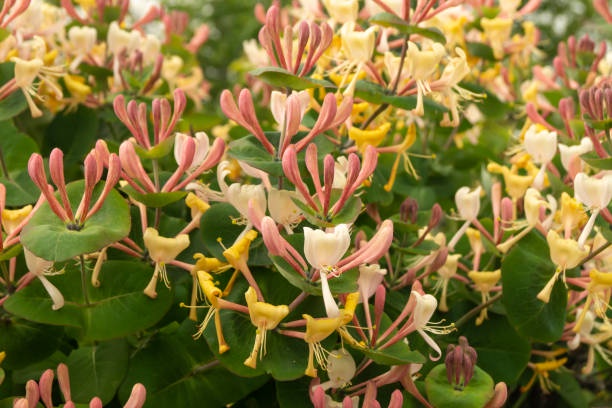Japanese Honeysuckle (Lonicera japonica) is a graceful and fragrant climbing vine that graces gardens with its cascading blooms. Propagating Japanese Honeysuckle is not only a rewarding horticultural endeavor but also a way to spread the beauty of this exquisite plant. This article unfolds the art of propagating Japanese Honeysuckle, guiding enthusiasts from the delicate bud stage to the enchanting blossoms, exploring methods, tips, and the joy of nurturing this beloved vine.
Unlocking the Secrets of Japanese Honeysuckle Propagation
Before delving into the propagation process, understanding the basic characteristics and preferences of Japanese Honeysuckle is crucial. Known for its vigorous growth and sweetly scented flowers, this deciduous vine thrives in well-drained soil and prefers partial to full sunlight. With its twining stems and ovate leaves, Japanese Honeysuckle provides an ideal canvas for propagation.
Propagation Methods
Rooting the Way to New Growth
Propagation of Japanese Honeysuckle can be achieved through various methods, each offering its own set of advantages. Here are the primary methods employed by horticulturists and gardening enthusiasts:
Cutting Propagation: Cuttings provide a reliable method for propagating Japanese Honeysuckle. Select healthy stems, typically around 4 to 6 inches in length, and cut just below a leaf node. Remove the lower leaves to expose a few nodes and encourage root development. Plant the cuttings in a well-draining medium and keep them consistently moist until roots develop.
Layering: This method involves encouraging the plant to produce roots while still attached to the parent plant. Select a healthy and flexible stem, make a small incision, and secure the wounded area to the soil with a U-shaped pin or a small stone. Once roots have developed, the new plant can be separated from the parent.
Seed Propagation: While less common, Japanese Honeysuckle can be grown from seeds. Collect seeds from mature pods and plant them in a seed-starting mix. Keep the soil consistently moist until the seedlings are ready for transplanting.
Step-by-Step Guide to Cutting Propagation
Nurturing New Growth from Cuttings
Cutting propagation is a popular and effective method for propagating Japanese Honeysuckle. Follow these steps to propagate your thriving vines:
Step 1: Select Healthy Cuttings
Choose healthy stems that are free from diseases or pests. Opt for young, flexible shoots with a vibrant green color. Ideally, the cuttings should be around 4 to 6 inches in length.
Step 2: Prepare the Cuttings
Using sharp, clean scissors or pruning shears, make a clean cut just below a leaf node. Remove any leaves that would be submerged in the planting medium, leaving a few leaves near the top to support photosynthesis.
Step 3: Stimulate Root Growth
Dip the cut end of the stem in a rooting hormone to stimulate the development of roots. While this step is optional, it can enhance the success rate of rooting.
Step 4: Planting in a Medium
Plant the cuttings in a well-draining propagation medium, such as a mixture of perlite and peat moss. Make a hole in the medium using a pencil or similar tool and insert the cutting, ensuring at least two nodes are buried.
Step 5: Maintain Moisture and Humidity
Keep the planting medium consistently moist to encourage root development. Cover the cuttings with a plastic dome or place them in a plastic bag to create a humid environment that aids in root formation.
Step 6: Transplanting
Once the cuttings have developed strong roots, typically in 4 to 6 weeks, they are ready for transplanting. Gently remove them from the propagation medium and transplant them into larger containers or directly into the garden.
Tips for Successful Propagation
Nurturing New Life
Timing Matters: Choose the right time for propagation. Spring and early summer are ideal seasons when the plant is actively growing.
Healthy Parent Plants: Select cuttings from healthy parent plants to ensure the propagation of robust and disease-resistant vines.
Rooting Hormones: While not mandatory, using rooting hormones can expedite the rooting process and increase success rates.
Consistent Moisture: Maintain consistent moisture levels during the propagation phase. This is crucial for root development.
Optimal Conditions: Provide the newly propagated plants with optimal conditions, including suitable sunlight and well-draining soil.
Enjoying the Blossoms
The Fruits of Your Propagation Labor
As the propagated Japanese Honeysuckle vines grow and mature, they will reward you with their fragrant and intricate blossoms. The vines will begin to twine and climb, showcasing clusters of tubular flowers that transition from creamy white to pale yellow as they unfurl. The sweet fragrance will attract pollinators, adding a lively and enchanting element to your garden.
Troubleshooting Common Issues
Overcoming Challenges in Propagation
Even with careful attention and proper techniques, challenges may arise during the propagation process. Here are common issues and solutions:
Rotting Cuttings: If cuttings are rotting instead of rooting, it may indicate excessive moisture. Adjust the watering frequency and ensure proper drainage.
Slow Root Development: If roots are slow to develop, consider adjusting the environmental conditions. Ensure the cuttings receive adequate warmth, light, and humidity.
Diseases and Pests: Keep an eye out for signs of diseases or pests. Treat affected cuttings promptly with appropriate measures, such as neem oil for pests or a fungicide for diseases.
Conclusion
From the tender buds to the blossoming vines, the art of propagating Japanese Honeysuckle is a delightful journey for gardening enthusiasts. Whether you choose cutting propagation, layering, or seeds, each method carries its own magic, allowing you to witness the transformation of new life. As you nurture these vines and witness the sweet-scented blossoms emerge, you not only expand your garden but also share the beauty of Japanese Honeysuckle with others. The art of propagation is a celebration of growth, beauty, and the enduring joy that comes from cultivating nature's wonders in your backyard. For more details about Essential oils Australia contact us.


No comments yet